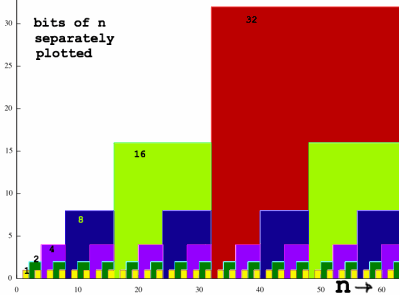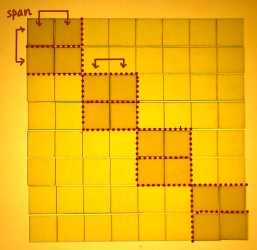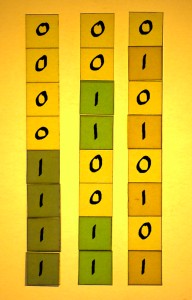
The previous page showed a plain FFT routine, quite
literally derived from matrix illustrations of Fast Fourier Transform.
On this page, I will redo that routine using some bitwise shortcuts
that I have found since then. Not all of these modifications are
intended to make the routine faster. It is more about exploring
possibilities.
The basis for the bitwise operations is the bitpattern in the
indexnumbers of an array with length N = 2x, x being a
positive integer. I have plotted the individual bits in a natural
sequence to visualise the pattern:
 |
The bitpattern corresponds to patterns in the FFT stages. Let me try
to illustrate this. For my N=8 example, the first stage has the
following pattern of entries that must be combined. The first half is a
4-point block where the 'span-bit' is lo, the second half is a 4-point
block where the 'span-bit' is set. The span-bit is binary 100 and has
decimal value 4. I have written the indexes of the input array in
binary to clarify what I mean with the 'span-bit' being lo or set:
 |
 |
In the second stage, the pattern is that of 2-point blocks where the
span=2 bit is alternating lo and set.
 |
 |
And of course this pattern extends to the last stage as well, where
the span-bit is 1:
 |
 |
The span variable is a pure power of two in every stage. We could
call the alternating blocks: zero and one, even and odd, or lo and set.
Here is an impression showing the blocks as being the bits of a natural
binary sequence:
 |
For radix 2 FFT with larger N, the pattern will expand in a
systematic fashion. The span variable regulates the flow of operations
in my basic FFT implementation to a great extent. After playing around
with bitwise methods I found still more employment for span. One level
of branching, the loop over the submatrices, can be replaced by a
simple instruction to run over even or odd blocks exclusively. Let me
illustrate how to iterate over the odd blocks.
Normally, an index of a loop is incremented with 1, writing n++ in C
code. We replace the index variable n with odd because we are going to
iterate over the odd block components. The regular increment now reads
odd++. To make shure that iterations go over odd blocks exclusively,
write an extra odd|=span after the regular increment. That is an
inclusive-or. Index numbers with the span-bit low will be skipped, they
simply can not exist.
 |
To find the even part of the dual node pair that must go with the
odd part, write: even = odd^span. This is exclusive-or and it will
switch the span-bit off. Summarizing:
|
odd++;
// normal increment |
This is not the only option but it makes for the simplest adaptation
of my previous scheme. Before rewriting the code, I will discuss
another modification: a look-up table for the trigonometrics.
Recall that we need complex Nth roots of unity for the
rotations, the so called twiddle factors. Actually, because we work
with aliases on the unit circle, we only need half a cosine function
and half a minus-sine function. Here is a picture from the earlier
pages to refresh:
 |
A separate
function can be written, which is called once in main, to fill arrays
realtwiddle[n] and imtwiddle[n] with real and imaginary parts of the
roots of unity.
|
N = 1<<logN; for(n=0; n<(N>>1); n++) |
In the FFT routine, the twiddle factors must now be found by their
indexes.
I will declare a variable 'rootindex' for that purpose. In the first
FFT stage, the indexes 'even' and 'rootindex' coincide. But in later
stages the frequencies increase and the indexes do not coincide any
more. We must run faster over the arrays with roots. This can be done
with help of a variable that starts at zero and is incremented by one
for every stage. Let me call this variable 'log', as I will use it as a
base 2 logarithm, and bitwise shift the even index with it. Further,
the rootindex shall never exceed N-1. The modulo 2pi wrap was
formerly secured by the sin and cos functions, but now we are
responsible. It is fixed by bitwise-and masking. The code will look
like
this:
|
rootindex = (even<<log) & (N-1); |
From the description the impression could arise that we have a lot
more variables now, but actually the opposite is true.
| void fft(double *real, double *im, double *realtwiddle, double *imtwiddle, int N) { unsigned int even, odd, span, log, rootindex; // indexes double temp; log=0; for(span=N>>1; span; span>>=1, log++) { for(odd=span; odd<N; odd++) // iterate over the dual nodes { odd |= span; // iterate over odd blocks only even = odd ^ span; // even part of the dual node pair temp = real[even] + real[odd]; real[odd] = real[even] - real[odd]; real[even] = temp; temp = im[even] + im[odd]; im[odd] = im[even] - im[odd]; im[even] = temp; rootindex = (even<<log) & (N-1); // find root of unity index if(rootindex) // skip rootindex[0] (has an identity) { temp=realtwiddle[rootindex]*real[odd]-imtwiddle[rootindex]*im[odd]; im[odd]=realtwiddle[rootindex]*im[odd]+imtwiddle[rootindex]*real[odd]; real[odd] = temp; } } // end of loop over n } // end of loop over FFT stages } //end of function |
What is the advantage of the 'jump-over-the-even-blocks' method? In
an FFT, there are 2log(N) stages, N-1 submatrices, and 2log(N)*(N/2)
dual node pairs in total. That means, I traded N-1 submatrix iterations
for 2log(N)*(N/2) extra instructions. Sounds like a bad
deal. The workflow is better streamlined however. The amount of
iterations over the inner loop is fixed at N/2 in each FFT stage. The
inner loop
can be unrolled to an extent of choice, eventually reducing overhead of
branching.
Just for fun, I also figured out a decrementing version of the
above. Iterations would then go over the even blocks exclusively. From
even, find the odd-block value for the dual node pair, by setting the
span bit high. From there, the even value is redefined by clearing the
span bit. Notice that even[0] and odd[span] would not be computed
unless the traditional decrement is placed within the curly brackets,
and the initialisation of even is altered accordingly (otherwise it
would be even=N-1-span).
|
.... |
It may seem odd to set a bit and then clear it again, but initially
you do not know the status of the bit and this is the easiest way to
have control. Juggling around with loop indexes this way is quite
delicate and can easily result in illegal index values or endless
loops. But once everything is set correctly, it should be reliable like
a conventional loop.
The last stage of my FFT routine contains no twiddles. With this stage
peeled off the outer loop, it can eventually do normalisation instead
of twiddling.
|
....
// last FFT stage has normalisation, no twiddling double norm = 1./N; // normalisation variable for(even=N; even; )
|
Notice that the normalisation type is a matter of choice. It can be
different from 1./N, depending on the transform purpose. I have done a
separate page on that topic, Normalisation Matters.
This leads me to another question: how to derive the inverse FFT?
Apart from normalisation matters, there is also the question of the
reversed rotation in the inverse transform. The imaginary twiddle
factors should be sign-inverted, that is easy enough. But when I
started figuring out a bitwise solution for that, I stumbled upon a
surprise, which is described on the next page.